Hepatitis B virus (HBV) infection is known to be associated with the risk of hepatocellular carcinoma (HCC), but how and why they are connected remains unknown. Researchers from Mass General Brigham discovered that HBV does not cause liver inflammation or cancer on its own, but worsens liver inflammation and may make patients more susceptible to early cancer development caused by environmental carcinogens. Limiting carcinogen exposure or reducing inflammation could mitigate this risk. The results are published in Nature Communications. “Our…

For more than 150 years, people around the world have made ample use of the explosive trinitrotoluene, otherwise known as TNT. Its use has had unintended consequences, however: the manufacture, storage and disposal of TNT—which ranks among the most toxic explosives employed by the military—have left large areas of land contaminated and polluted. So far, effective and affordable cleanup technologies have remained out of reach. But new research suggests that help may come from what might seem an unlike
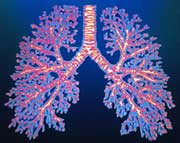
Radon may pose a greater cancer threat than has been thought.
Radon damage from irradiated cells spreads to their neighbours, a new study finds 1 . The result suggests that small amounts of this radioactive gas could cause widespread harm.
The study “is a reason for concern but not panic”, says Gerhard Randers-Pehrson of Columbia University, New York, a member of the team that performed the study. “We’re talking about the acceptable level of radon changing pe
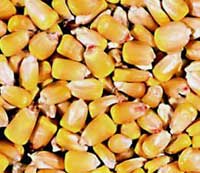
In news that will surely fan the flames of the heated debate over genetically modified crops, scientists have found evidence that genes from GM plants can spread far and wide to native ones. According to a report published today in the journal Nature, wild corn from the remote mountains of Oaxaca, Mexico contains transgenic DNA. This, the researchers note, bolsters concerns that such unintentional contamination can threaten the genetic diversity of natural crops.
DNA analyses of the Oaxaca

Generally speaking, we go to great lengths to rid our bodies of foreign bacteria, whether it’s by brushing our teeth, washing our hands or taking antibiotics. But new research suggests that when it comes to treating tumors, we may one day invite the bugs in. According to a study published yesterday in the early online edition of the Proceedings of the National Academy of Sciences, a bacterium that normally resides in soil, dust and dead flesh quickly destroys large tumors in mice when injected along
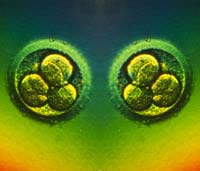
Rewiring the egg: mechanism remains murky.
From a scientific viewpoint, the cloning of human embryos may be more of a step than a leap, say sceptics. If the signals that turn adult cells into embryonic ones can be found, the creation of cloned embryos for tissue repair may become redundant.
Researchers at Advanced Cell Technology (ACT) in Worcester, Massachusetts, now report that they have created cloned human embryos. They aimed to make blastocysts, hollow balls of cells fr

The size and types of the largest local land animals vary greatly from place to place, prompting scientists to question what controls the success of animals of certain sizes over others. Now a report published in the current issue of the Proceedings of the National Academy of Sciences shows that the size of a landmass limits the maximal body size of its top animal.
Gary Burness and Jared Diamond of the University of California School of Medicine, together with Timothy Flannery of the South

New research is helping to unravel the machinery that allows a mosquito to sniff out its human quarry, which could lead to more and better ways of foiling the disease-spreading insects. A report published today in the online version of the Proceedings of the National Academy of Sciences describes four genes that appear to produce odor-sensing molecules in Africa’s Anopheles gambiae, a carrier of malaria, the number two killer in the developing world. Understanding how such genes operate could en

An immune system chemical may undo skin damage by sunlight.
A chemical involved in immune-system signalling may be able to reverse some types of skin damage caused by sunlight. It could reduce sunburn by activating DNA-repair mechanisms, a new study suggests, raising the possibility that the chemical might be used to prevent or treat skin cancer 1 .
High-energy ultraviolet light is thought to promote skin cancer by damaging the DNA within cells. Skin cancer,

Talk about multi-tasking. A new study reveals that in the St. John’s Wort plant, Hypericum calycinum, the same chemical not only attracts pollinating insects but also deters herbivores that pose a threat to its survival. The findings appear in the current issue of the Proceedings of the National Academy of Sciences.
To the human eye, the flowers of H. calycinum appear as uniform yellow disks (top image). Insects with ultraviolet-sensitive eyes, however, see a dark, ultraviolet-absorbing ce
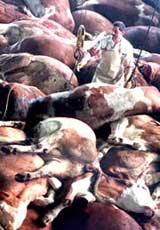
While prion diseases seem to be waning in humans, they could be waxing in sheep.
Variant Creutzfeldt-Jakob disease (vCJD) may claim only around 200 victims, a new model predicts 1 . This degenerative brain disease is thought to occur when people are exposed to misfolded prion proteins from meat infected with bovine spongiform encephalopathy (BSE or ’mad cow disease’).
Meanwhile, another study warns that a huge BSE epidemic could be brewing in the UK

Evolution may make men ignorant and gullible.
Gentlemen: ignorance is bliss and gullibility is the best policy. A new mathematical analysis suggests that evolution favours babies who don’t much resemble their fathers, and males who believe their partner when she says a child looks just like him.
Anonymous-looking newborns make for uncertain fathers. But they also allow men to father children through undetected adultery, Paola Bressan of the University of Padova calculates

Researchers have discovered the mechanism by which the genetic defect underlying cystic fibrosis (CF) leads to fatal bacterial colonization of the lungs. The new findings, published today in the early online edition of the Proceedings of the National Academy of Sciences, suggest that an aerosol treatment aimed at balancing pH in lung cells could be developed to stave off or delay such infections.
The most common inherited lethal disorder in Caucasians, CF stems from mutations in a gene that
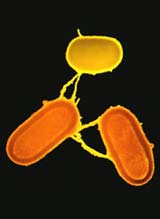
Bacteria caught mating with mammalian cells.
Cross-species coupling is generally frowned upon. But in the liberal labs of California it is actively being encouraged. Bugs that are persuaded to get down and dirty with hamster cells are rewriting sex manuals in the act.
Like humans, bacteria mate using a timely protruding phallus. It suckers a nearby bacterium and drags it close enough to shoot in DNA – a process called conjugation.
Although bacteria have been persuad
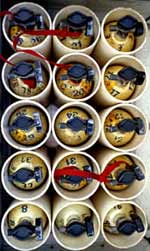
Scientists have detected a molecule they’ve been looking for since the 1920s.
Scientists in Italy have discovered a new form of oxygen 1 . In addition to the two well-known forms – ozone and the oxygen molecules in air – there is a third, they say, in which oxygen atoms are grouped in fours.
The oxygen molecules that we breathe (denoted O 2 ) consist of two oxygen atoms. This, the most stable form of oxygen, makes up about one-fifth of air. Ozone is
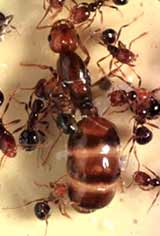
One gene controls whether a persistent pest serves one or many queens.
A protein that spots smell controls the power structure of fire ant colonies, Michael Krieger and Kenneth Ross of the University of Georgia, Athens, have discovered 1 . One form of the protein leads to nests with several queens living in harmony. The other leaves only one ruler.
Fire ants’ social life is of more than academic interest. The species (Solenopsis invicta) has spread from
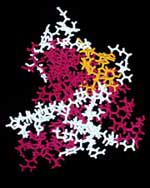
A gene may protect people against variant Creutzfeldt-Jakob disease.
People who lack a gene involved in immune responses may be three times more likely to suffer from variant Creutzfeldt-Jakob disease (vCJD), a new study suggests1. The result, if borne out in larger studies, could point researchers toward therapies for the incurable brain disease.
vCJD is thought to occur when people are exposed to misshapen prion proteins from cows with bovine spongiform encephalopathy – B